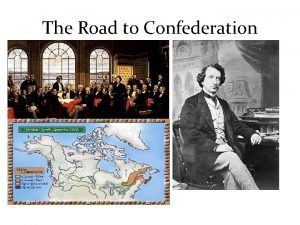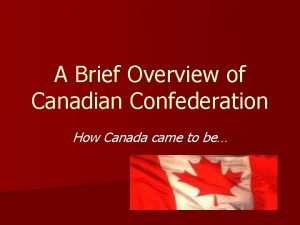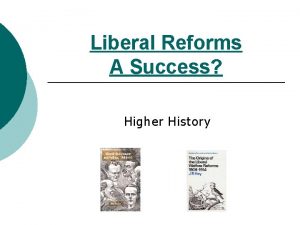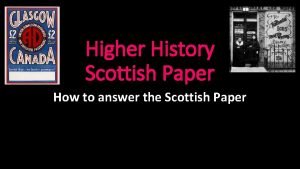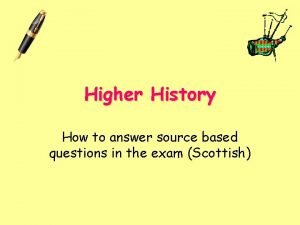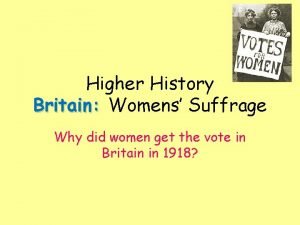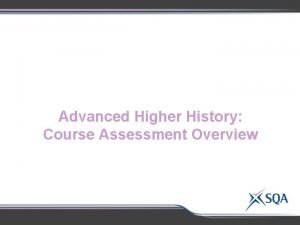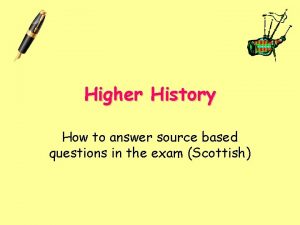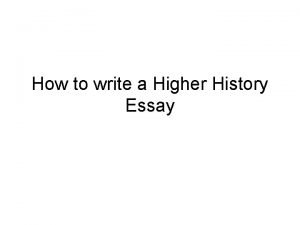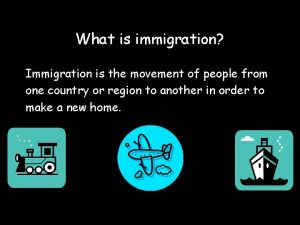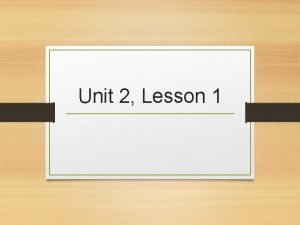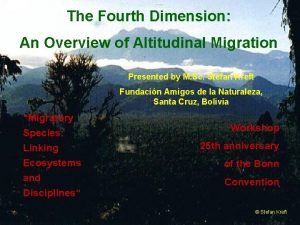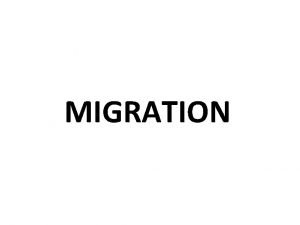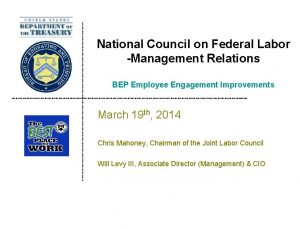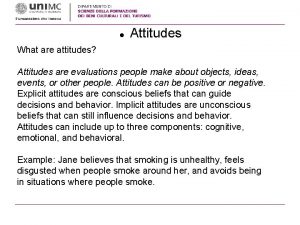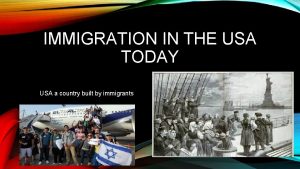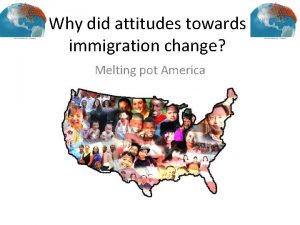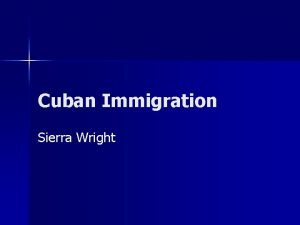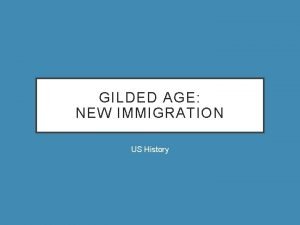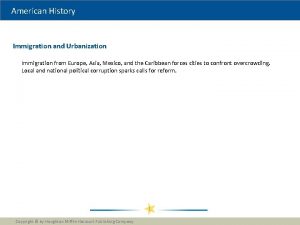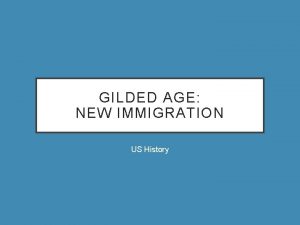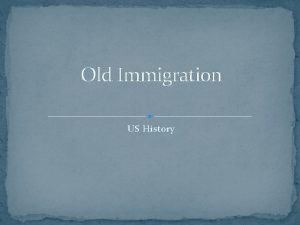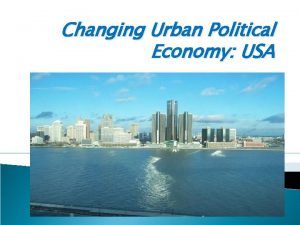Higher History USA Changing Attitudes to Immigration Why






















- Slides: 22

Higher History USA: Changing Attitudes to Immigration Why did the open door close?

We are learning to… Explain why Americans changed their attitude to immigrants in the 1920 s I can… Build up notes on the topic Plan a 20 mark essay Pass a 20 mark timed essay

Background (need for intro) • In the 19 th and early 20 th centuries, millions of Europeans migrated to the USA seeking a better quality of life for themselves and their families they wanted to achieve 'The American Dream'. • America was a land full of opportunity and it needed a steady flow of immigrants as the economy had expanded rapidly after the end of the Civil War in 1865. • The American government adopted an ‘open door’ policy on immigration. This is summarised on the inscription at the foot of the Statue of Liberty. • ‘Give me your tired, your poor, Your huddled masses yearning to breathe free’ • Some immigration, such as that from China had been limited since the 1882 Chinese Exclusion Act, however the United States generally had an ‘open door’ to immigrants chasing the American dream • However, in the 1920 s that started to change; many Americans changed their attitude towards those hoping to come to America

The arguments for changing attitudes to immigrants 1. 2. 3. 4. 5. ‘The Factors’ Isolationism Fear of Revolution Prejudice and Racism Economic & Social Fears The Effects of WWI You should aim to cover 4 of these in your essay; but you must know all of them in case it is the isolated factor.

Isolationism: Knowledge The USA at the start of the 20 th century was strongly isolationist, meaning they wanted to stay firmly out of the affairs of Europe and other countries • The Alien Land Law of 1913 forbade ‘aliens’ from owning any agricultural land in California. It was meant to apply to all recent immigrants but was more directed at the Japanese. Eleven other states quickly followed the Californian example • At the beginning of the first world war, US public opinion was strongly one of neutrality – wanting to stay well clear of European problems • President Woodrow Wilson warned that the USA should not become involved in Europe’s ‘Civil War’ in his Appeal for Neutrality In 1918 • When the war ended, most Americans wanted to return to this Isolationist policy • The USA had refused to join the League of Nations, with most Senators concerned that joining would see America being dragged into another European war • Many citizens and politicians supported a movement called 100% Americanism, Americanism a type of nativism, and were known as ‘nativists’


Isolationism: Analysis • This shows that many Americans around 1920 were wary of outside influence and felt strongly that the USA needed to isolate itself from European & word affairs, and becoming anti-immigration was a natural extension of this (analysis) • The government led by example in it’s isolationist strategies and the unwillingness of President Wilson and the Senate to become involved in European affairs led many Americans to believe that European immigration needed to be reduced and therefore their attitudes to immigration changed (analysis)

Fear of Revolution: Knowledge • The Russian Revolution in 1917 had seen the autocratic Tsar Nicholas ousted in a bloody revolution by the Bolsheviks (communists). The establishment of the world’s first Communist state had sent shockwaves and panic across the world • The ‘Red Scare’ was the name given to the wave of hysteria that swept across America in 1919 provoked by the fear that a Communist revolution would occur in the USA and the American ‘way of life’ would be gone forever • The Palmer Raids in November 1918 were a series of raids by the US Dept. of Justice (led by Attorney General A. Mitchell Palmer) intended to capture, arrest and deport radical leftists, especially anarchists • More than 500 citizens were formally deported by the Palmer Raids (and Palmer wanted more), resulting in strikes and a bomb sent to Palmer’s home


Fear of Revolution: Analysis • This shows that many Americans had become very fearful of the possibility of a Communist revolution and the spread of Anarchism throughout the USA by the 1920 s and this was a very real fear of many, fuelled by the Russian Revolution in 1917 and Spartacist Revolt in Germany in 1919 (analysis) • The government helped spread fear and panic through it’s reaction to the Red Scare i. e. the heavy handed Palmer Raids and this contributed to many US citizens changing their attitudes to immigration as a result (analysis) • However, For many the Palmer Raids were a step too far and while most Americans were shocked after the bombing it did not lead them to fear the ‘Reds’ in the way the media portrayed (analysis +)

Prejudice & Racism: Knowledge • Between 1820 and 1880, the majority of immigrants were from Britain, Germany and Scandinavia. These ‘old immigrants’ became known as WASPS – White Anglo-Saxon Protestants • The ‘new wave’ of immigration (1880 -1920) tended to be from Southern & Eastern Europe – Italy, Greece, Russia – and the WASPs held these immigrants in contempt • These ‘new immigrants’ tended to be Catholic or often Jewish and this was seen as a threat to Protestantism in the US. In addition, many were darker skinned and some illiterate; this worried WASPs • Many ‘new’ immigrants were also unfamiliar with democracy which seemed to threaten the American Constitution • Many new immigrants also failed to assimilate (fit in) as they didn’t speak English, wore their own traditional dress and stuck to their own communities like ‘Little Italy • An example of this was the widely read articles of Kenneth Roberts in the Saturday Evening Post where he Urged that the immigration laws be revised to admit fewer Polish Jews who were “human parasites”


Prejudice & Racism: Analysis • This shows that by the 1920 s a hierarchy of immigration as in existence – old ‘WASP’ immigrants saw themselves as better than the ‘new’ immigrants From South & Eastern Europe and wanted to control the numbers of ‘new immigrants’ coming to the country (analysis) • The press added to this prejudice and racism by fuelling fears of the US Public that new immigrants were threatening the American ‘way of life’ and therefore many Americans began to call for immigration restrictions (analysis) • However, It was not the increased numbers but the changing nature of immigrants which led to calls for tighter controls so many wanted a different type of immigration rather then less immigration (analysis +) • Also, Evidence of prejudice towards immigration was not a new thing and this was evidence in the restrictions introduced in the 19 th century such as the Federal Immigration Act of 1882 (analysis +)

Economic & Social Fears: Knowledge • Because immigrants tended to stick together in their own cultural communities they were often viewed with suspicion – many were blamed for crime and antisocial behaviour – immigrant communities were often overcrowded and squalid as immigrants were poorly paid • Use Sacco & Vanzetti here • Trade Unions believed that any positives they achieved in terms of working conditions and wages was wrecked by Italian or Polish workers who would work longer hours for less money. They even backed the idea of a literacy test for immigrants believing that many unskilled workers would be denied entry into the USA. • In 1919 during a wave of strikes over issues like post war inflation, immigrants were often brought in as strikebreakers which greatly angered many American workers & created resentment towards immigrants

Sacco and Vanzetti • Radical Italian immigrants • Accused of double murder in Massachusetts • Both had alibis (inc a work time card) • Many defence witnesses spoke in broken English and were manipulated by the prosecution • Hat apparently belonging to Sacco found at the scene did not fit him • Executed 1927 – many believed it was due to their nationality and politics rather than hard evidence • https: //www. youtube. com/wa tch? v=N 0 s. YAU 96 FY 0 I am suffering because I am a radical. Indeed I am. I have suffered because I am Italian. Indeed, I am. Bartolomeo Vanzetti

Economic & Social Fears: Analysis • Economic and Social Fears were significant in changing attitudes towards immigration because many Americans viewed immigrant communities with disdain and suspicion and started to believe that immigrants were contributing to increased levels of crime, fuelled by high profile cases like Sacco & Vanzetti, and this led to calls for restricted immigration (analysis) • When wages were low and work was difficult to find, immigrants were used as scapegoats for unemployment and reduced availability of work and when immigrants were used as strike breakers it made many Americans worry about their own economic situation, fuelling antiimmigration feeling (analysis)

The Effects of WWI • During WWI, many immigrants naturally had sympathies for their mother country i. e. Germany, Italy, Austria who were fighting against the Allies • Germans in particular supported Germany in the war and this created a huge divide when the USA joined the war against Germany in April 1917 • Many also viewed Irish immigrants with suspicion as they were seen to be anti-British due to issues between the countries, especially if they were Catholic • Many US citizens began to view anything ‘foreign’ with hostility – German language teaching was banned in schools & colleges, German people started changing their names and the German dish Sauerkraut was renamed ‘liberty cabbage’ • Troops returned home seeking jobs in the already saturated labour market; factories closed and people lost their jobs. Many Americans were struggling for work or to make ends meet in the ‘hungry 20 s’


The Effects of WWI: Analysis • The wartime xenophobia (fear of foreigners) continued into the 1920 s and it was difficult for many Americans to forget the anti-German rhetoric and moves of the wartime period such as the banning of German language, leading to racism and hostility towards many European immigrants (analysis) • The unemployment and financial difficulties of the 1920 s were often blamed on immigration and many Americans felt that they should be prioritised in the Labour market over immigrants, leading to many Americans calling for restrictions on further immigration (analysis) • However, Immigrants were encouraged to buy Liberty Bonds to support the war effort and did so in their thousands. This shows that America was in fact reliant on the immigrants. (analysis +)

Essay Questions • Immigration is an example of an isolated factor essay – this means the SQA will ask you whether women got the vote because of a specific factor (one of the 5 we cover) • You must talk about the factor in the question BUT you do not need to agree it is the most important • Examples • How important was fear of revolution as a reason for changing attitudes towards immigration in the 1920’s? • To what extent was the effect of the First World War the most important reason for changing attitudes towards immigration in the 1920’s?

Introduction – 3 step plan • Background (give 2 -3 sentences of what America’s immigration policy was like before changing attitudes ‘Before the 1920 s…’ • Factors (what are the factors in the essay? ) There were many important factors in the changing attitudes towards immigration such as (a list is fine) • Argument (what will you be arguing is most important? ) It can be argued that the most important factor was …because…

Conclusion – 4 step plan • In conclusion, there were many reasons for changing attitudes to US immigration in the 1920 s. • On the one hand… (you should take one key factor here and explain why it was important) • On the other hand… (now you should do the same with another key factor to balance your argument) • Overall, the most important factor was… (keep your strongest until last, backing up why it is so important and it should be clear why it outweighs the other factors)
 Characteristics of quality culture
Characteristics of quality culture Confederation changing british attitudes
Confederation changing british attitudes Changing british attitudes confederation
Changing british attitudes confederation Hey bye bye
Hey bye bye Dont ask
Dont ask Liberal reforms essay higher history
Liberal reforms essay higher history Higher history paper 2
Higher history paper 2 Higher history source questions
Higher history source questions Higher history women's suffrage essay
Higher history women's suffrage essay Advanced higher history
Advanced higher history Advanced higher english dissertation word limit
Advanced higher english dissertation word limit Source based questions history
Source based questions history How to write a higher history essay
How to write a higher history essay Bbc bitesize liberal reforms
Bbc bitesize liberal reforms Higher history women's suffrage essay
Higher history women's suffrage essay Pull factors of canada
Pull factors of canada What is immigration
What is immigration How did esperanza help marta during an immigration sweep
How did esperanza help marta during an immigration sweep Fourth dimension immigration
Fourth dimension immigration Difference between immigration and emigration
Difference between immigration and emigration Emigration definition ap human geography
Emigration definition ap human geography Emmigration definition
Emmigration definition Contingent workforce compliance
Contingent workforce compliance

